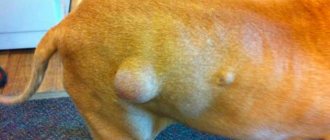Causes of distemper in dogs
The development of distemper in dogs occurs for one, only reason - the penetration into the animal’s body of a highly contagious virus belonging to the paramyxovirus family. It is characterized by the following features:
- capable of very rapid reproduction;
- has a strong pathogenic effect on the body;
- can affect several organ systems at once or a specific one;
- remains active in the physiological secretions of a sick dog for a week, and under favorable conditions, even more.
Once the virus enters the animal’s body, the dog itself becomes its carrier and source of infection.
Symptoms and signs of distemper in dogs
The incubation period (the moment the virus enters the body before the first signs of distemper appear) in a dog lasts 3-21 days or more, sometimes 60-90 days. With the development of animal immunity, the clinical picture of distemper has changed significantly in recent years.
Previously, distemper in dogs occurred in clinically pronounced forms with fever and intoxication, but recently atypical forms have been more often recorded or the disease occurs in conjunction with other infectious diseases.
In the early stages (3-5 days) the disease is characterized by:
- weakness and lethargy
- poor digestion
- bilateral (on both sides) serous, serous-purulent conjunctivitis;
- in the morning or during the day, the eyelashes are glued together with pus (white, gray or greenish), it is difficult to open the eyes;
- severe photophobia appears.
- dogs go into the shade, hide under a closet, bed or table, and strive for a cool place.
In parallel or later (after 3-5 days) the following develops:
- rhinothea (profuse nasal discharge);
- dry cough, which becomes wet after 5-7 days, especially with timely treatment;
- nasal discharge is clear, cloudy or greenish in color.
Forms of plague and course of the disease
Distemper in a dog
Depending on the severity of the clinical symptoms of plague, several types of plague are conventionally distinguished:
| Types of plague | ||
| Form | Symptoms | |
| Skin | The appearance of red spots with signs of inflamed skin, as well as ulcers and pus. The mildest form of distemper, but if proper treatment is not carried out in time, there is a high risk of death of the dog. | |
| Intestinal (gastrointestinal) | It manifests itself as serious damage to the digestive system, including acute gastroenteritis, and is accompanied by refusal to feed, vomiting, as well as constipation and diarrhea, which leads to dehydration and rapid exhaustion of the dog. Feces contain a lot of mucus, often mixed with blood. | |
| Pulmonary (respiratory) | It is characterized by severe damage to the respiratory system: first the upper and then the lower respiratory tract. In this case, rhinitis, tracheitis, bronchitis, pneumonia or their mixed forms (acute catarrh of the upper respiratory tract, tracheobronchitis, bronchopneumonia) consistently develop. | |
| Nervous | The most severe form of distemper in dogs . The prognosis is often unfavorable. Serious complications include meningitis, encephalitis, meningoencephalitis, myelitis, paresis and paralysis of the limbs and sphincters of internal organs, as well as epilepsy. They develop as a result of the introduction of a virus into the cells of the spinal cord, brain and its membranes. Symptoms appear 2-6 weeks after infection. In weakened and immunized dogs, these symptoms can occur suddenly, without prior development of symptoms of general intoxication, high fever, etc. | |
| Mixed (generalized) | The generalized form occurs in 90-95% of cases of dog disease. It includes clinical symptoms of cutaneous, pulmonary, intestinal and nervous forms. The division into these forms of plague is conditional. | |
The development of one form or another is largely determined by the reactivity of the dog’s body. The same strain of the pathogen causes different clinical signs, ranging from a temperature reaction to nervous symptoms.
Also, in addition to the severity of clinical symptoms, plague can be divided according to the speed and method of the disease. The following forms of the disease are distinguished:
- Lightning fast. With a lightning-fast course, there are no obvious signs of the disease, the death of the animal occurs within one day.
- Spicy. In acute cases, a sharp increase in body temperature to 39.5 - 41 ° C is noted, especially in the evenings or at night. Appetite is distorted, but most often decreases, and at high temperatures completely disappears. Thirst increases. A comatose state develops, in which the dog or puppy dies on the 27th day of the disease.
- Subacute. Characterized by high fever that lasts from one day to two weeks. Then the fever becomes mild. In puppies 1-1.5 months of age, the temperature rises slightly or remains within normal limits. Along with fever, sick dogs exhibit depression, lethargy, muscle tremors, fearfulness, loss of appetite, dryness and roughness of the nasal mucosa. In rare cases, hardening of the paw pads may occur.
- Chronic. Most often characteristic of cutaneous and nervous forms. At the same time, in recovered animals, convulsive twitching of individual muscle groups, cuts and paralysis, as well as blindness, deafness, loss of smell, scars on the cornea, overgrowth of the pupil or atrophy of the eyeball, epilepsy remain for a long time, often for life.
- Abortive form. With a benign course, the clinical symptoms of plague are practically erased and often go unnoticed.
A good example is that a dog has a nervous form of distemper.
Where can a dog get distemper?
A dog infected with distemper. Note the purulent discharge and hyperkeratotic nose.
A dog can become infected with distemper anywhere, even at home. The source of infection is the secretions of another animal - a carrier of the virus. The virus can enter the body of a healthy pet in two ways: through the digestive tract and the respiratory system, so almost any object poses a danger, not to mention direct contact with a sick dog. This:
- feces, discharge during estrus, saliva, etc.;
- booth, aviary;
- Bowl;
- litter and so on.
The owner himself can “bring” distemper infection into the house, for example, on shoes. Cats can transmit the virus in the same way if they walk outside but come home to spend the night.
Who carries distemper in dogs and is it transmitted to humans?
This virus infects many animals en masse. Most often they become infected:
- ferrets;
- foxes;
- wolves;
- raccoons, etc.
Who is at risk? All dogs that have not been vaccinated. Puppies no older than 16 weeks are especially vulnerable because they have impaired passive immunity transmitted through mother's milk.
The carrier of the virus is an animal that becomes infected and releases virions during the incubation period or the clinical course of the disease.
Previously, it was believed that a sick dog poses a danger not only to its relatives, but also to humans. It has now been proven that this is not so: the owner does not have to worry about his health. It is much more important to pay full attention to your pet and provide him with reliable protection from the virus.
Mechanism of disease development
After the distemper virus has entered the animal’s body, it begins to actively multiply. The owner will not immediately determine that his pet is sick. The first days the dog is in its normal state. The latent reproduction period of the virus can be an average of a week, but sometimes two or even three. A very rare situation occurs when signs of the disease appear 2-3 days after contact between a healthy and an infected dog. This is only possible if the animal has virtually no immunity.
Note: a dog that has had distemper remains immune to the virus for life.
After the incubation period has passed and the virus has multiplied sufficiently, the first signs of the disease appear.
Initial symptoms of canine distemper
How does canine distemper manifest at the initial stage? The most common primary symptoms include:
- lethargy;
- depressed look;
- swelling and redness of the eyes;
- tousled fur;
- sensitivity to light (the dog begins to look for a darker place);
- disorders of the digestive tract;
- mucous discharge from the nose and eyes.
Not all animals exhibit these signs to the same extent. Their severity depends on the state of immunity, lifestyle, age and other factors. In addition, some symptoms of plague may predominate, or others may be added to those listed (for example, increased body temperature). It is also important which organ system is most affected by the virus.
Incubation period and types of distemper in dogs
After infection, the disease does not manifest itself until the end of the incubation period, which lasts from 3 days to 3 weeks. The duration of incubation is affected by the health status of the infected person. On the first day, symptoms appear only in very weakened animals.
An infected dog is dangerous to other animals immediately after infection, regardless of the presence of clinical signs.
Depending on the system affected, the following forms of canine plague are distinguished:
- pulmonary;
- cutaneous;
- intestinal;
- nervous;
- mixed.
Pulmonary form
When the lungs are damaged, an inflammatory process develops, accompanied by:
- rise in temperature against the background of developing pneumonia;
- severe trembling and seizures;
- damage to the eyes with the release of pus and the formation of ulcers on the cornea;
- breathing complications disrupted by purulent formations in the sinuses;
- increased thirst and lack of appetite;
- vomiting and diarrhea;
- rhinitis and dry cough, changing to wet after a while.
Cutaneous form
The cutaneous form is considered mild and responds well to treatment. It is not accompanied by high fever and does not cause severe anxiety on the part of the pet.
Skin plague can be recognized by:
- the appearance of rashes, ulcers, blisters and purulent formations on hairless skin;
- the formation of inflammatory processes when bacteria penetrate through damaged areas;
- the appearance of red spots on the ears, nose, stomach and thighs;
- thickening of the skin in the joint area.
Intestinal form
When the intestines are damaged, the following is noted:
- weakness and fever;
- increased thirst;
- foul-smelling diarrhea with mucus, blood and particles of undigested food (a dark brown tint to the feces indicates a worsening condition);
- frequent bouts of vomiting with light yellow mucous secretions or blood clots;
- the appearance of dark spots on the enamel of teeth and white plaque on the tongue.
The intestinal form, which leads to severe dehydration, is fatal for puppies under 1 year of age and can only be treated if treated promptly.
Nervous form
In the case of a nervous form of the disease in a dog:
- aggression and irritation appear, giving way to apathy as the condition worsens;
- muscle cramps are observed;
- coordination of movements is impaired;
- paralysis of the limbs develops;
- there is strong thirst;
- there is a rise in temperature with preservation of appetite;
- epileptic seizures occur;
- control of bowel movements and urination is impaired.
If the muscle fibers of the lungs and heart are damaged, recovery is impossible. The animal dies from suffocation or cardiac arrest.
Mixed form
As a rule, the disease occurs in a mixed form, when several vital systems of the body are affected at once. This complicates the course of the disease and reduces the chances of recovery even with timely treatment.
Further development of the disease: forms of plague
Symptoms of distemper in dogs are rarely observed in isolated form, since the virus affects the entire body. However, based on those that are most pronounced, several forms of the disease are conventionally distinguished.
Form
Symptoms
Pulmonary
The animal's body temperature rises and a cough occurs. Discharge from the eyes and nostrils is purulent in nature. The dog refuses to eat and drinks a lot of water. Diarrhea and vomiting gradually develop.
Nervous
The animal is suffering from severe thirst. Muscle twitching is characteristic. Irritability and aggressiveness appear. If left untreated, the hind limbs become paralyzed and epilepsy occurs. When the cardiac and pulmonary muscle fibers are paralyzed, the dog dies.
Intestinal
The pet does not eat, is very weakened, to the point of losing consciousness. The surface of the tongue becomes white due to plaque. The animal suffers from vomiting and diarrhea. In the latter case, the discharge is yellowish.
Skin
Rashes appear on the pet’s body, which later develop into pustules and ulcers. If they become infected, severe inflammation occurs. Despite the fact that this form of the disease is considered the mildest in terms of prognosis, if left untreated, the pet may die from exhaustion.
In addition to classification according to the clinical picture, several forms of distemper in dogs are distinguished based on the duration of the disease.
- Lightning fast. Symptoms hardly appear, but the animal dies within 24 hours.
- Super acute. There is a very high temperature. The animal refuses food. Death occurs on the second or third day.
- Spicy. Characterized by the above symptoms.
- Chronic. Periods of remission alternate with relapses. The duration of the disease is up to several months.
Attention! If any deviations in the behavior or condition of the dog appear, you should immediately contact a veterinarian and get tested.
Description of the disease
The virus is transmitted by airborne droplets, and there is a possibility of becoming infected with contaminated food and water.
The virus in the body of a sick dog is widespread in the blood of the abdominal cavity and spleen. The virus enters the external environment through urine or feces, with discharge from the eyes and nose; pieces of exfoliated skin are dangerous. A dog can become infected through sexual contact with a sick dog or through water drunk from the same jug. The virus is carried on clothing and shoes. It is believed that it is easy to become infected with the plague through insects. Plague can occur at any time of the year, but most often occurs in the spring and autumn.
All breeds and dogs of any age are susceptible to this disease. It has been documented that young dogs are more likely to get distemper. Remember, up to two months, puppies have natural protection received through their mother’s milk. If a puppy was born from a mother who had the disease, but was vaccinated on time, the puppy will have the strongest protection against distemper.
How to identify a disease by symptoms
Distemper in dogs: symptoms and treatment. The incubation period for a sick animal is 3-4 weeks. At this time, it is impossible to know whether the dog has distemper. Form of the disease: extremely acute, acute, chronic, typical and fulminant (in the latter cases the dog dies instantly without showing symptoms).
Signs of illness in dogs:
- Body temperature rises slightly by 2-3 degrees. Please note that puppies do not develop a fever until they are half a month old;
- With acute distemper, the temperature rises sharply, the dog does not eat, falls into a coma, and the pet dies (the disease lasts 2–3 days);
- With acute plague, the disease lasts 3-4 weeks. The dog has a severe fever, the body temperature stays at 39-42 degrees for 8-12 days, sometimes subsides after 3-4 days;
- Depressed state;
- Reflexes begin to disappear;
- There is chills;
- The dog hides in a quiet dark place, does not respond;
- The pet stops eating;
- Possible vomiting.
Dog diseases affect different organs - symptoms of distemper
In case of respiratory tract infection:
- There is discharge of pus from the eyes or nose. Pus blocks the nasal passages, difficulty breathing occurs, and wheezing is heard;
- Cough and diarrhea will soon appear;
- The dog's temperature rises.
Diagnostics
After listening to complaints from the owner and examining the dog externally, the specialist will definitely prescribe laboratory diagnostics. In most cases, the study will require taking blood and swabs from the eyes (nose, mouth).
To identify a virus and determine its type, it is possible to use methods such as:
- enzyme-linked immunosorbent assay (ELISA) – allows you to detect the disease at an early stage;
- polymerase chain reaction (PCR) – also has high sensitivity;
- susceptibility test;
- tests to determine antigen in a dog’s blood;
- neutralization reaction - carried out to determine the species.
Today, there are many other laboratory diagnostic methods that can detect distemper virus in dog tissue. The choice of one method or another is within the competence of the specialist.
Is distemper treatable in dogs and what is its incubation period?
The virus does not make itself felt in some individuals for 3-4 days, and in some up to 90 days. This is the insidiousness of this deadly disease - an adult dog or a small puppy already carries virions within itself, and its owner has no idea about it.
Is there a cure for Carré's disease? Yes. But all veterinarians say that no one gives guarantees and in most cases you only improve your pet’s condition for a short time. However, there are also examples that inspire hope - stories of those owners who managed to save their pet. Is it possible to help an animal in critical condition by going to the hospital a few days after the onset of alarming symptoms? Unfortunately, your delay is a death sentence for the one you tamed.
Is there a drug that can cure a dog of distemper, how to get it? Such remedies exist, but only doctors prescribe them. Independent attempts to save a pet can lead to a deterioration in its health and rapid death.
Most often, a set of procedures is prescribed aimed at eliminating traces of intoxication in the animal’s body, relieving inflammation, and combating degenerative changes in the affected organs:
- A diet is required; in extreme cases, fasting. At the same time, the dog should always have clean water.
- In case of severe malnutrition, artificial feeding with the supply of nutritional mixtures directly into the rectum (preceded by bowel cleansing) is recommended.
- In the early stages of the disease, injections are given to maintain the body's defenses and fight infection (immunoglobulins and leukocyte interferon). Antihistamines and glucocorticoids are also used. In the treatment of canine distemper, antibiotics are actively used, selected depending on the symptoms, and vitamins B and C are administered.
- In case of inflammatory processes affecting the gastrointestinal tract, the animal may be prescribed artificial gastric juice for some time. Along with it, the doctor prescribes medications that have antipyretic and analgesic effects. After the improvement occurs, analgesics are replaced by astringents and drugs with antimicrobial activity.
- To prevent canine distemper, different vaccines are used - they destroy both the causative agent of one (monovalent) and several diseases (polyvalent). The latter is not recommended for small puppies - up to 6 months their body is too vulnerable.
photo from the site: VashiPitomcy.ru
The best option is domestic drugs. The following vaccines are currently used by veterinarians:
- Nobivak
- Boostervac
Prevention of plague
To prevent your dog from getting sick, the most important preventive measure is vaccination. The first time the distemper vaccine is given when the puppy is over 3 months of age. After this, vaccination will need to be carried out once every year.
The state of the pet’s immune system is of great preventive importance. The better the immunity, the lower the risk of infection and the higher the likelihood of a quick recovery in case of illness. Simple principles of keeping your dog will help strengthen your dog’s defenses:
- clean bedding and bowl;
- good nutrition;
- periodic introduction of vitamin complexes into the feed;
- regular walks.
Washing the paws upon arrival from the street will also help protect the animal from distemper, if the dog lives with the owner in the same room. In addition, you need to avoid dubious “acquaintances” with your four-legged friend, do not let him off the leash and do not leave him unattended.
Which dogs are at risk?
Any dog can get distemper, regardless of age and breed. Those four-legged friends who have weakened immune systems are more likely to become infected. These could be dogs recovering from another illness or injury, homeless yard animals, with an immune system weakened by malnutrition and lifestyle. In addition, a high incidence rate is recorded among puppies under one year of age. Puppies that are breastfed, as a rule, do not get canine distemper.
There are different degrees of risk of infection with distemper for dogs of different breeds. Thus, terriers and mongrels are considered more resistant to the virus. Owners of shepherd dogs who suffer from this disease quite seriously turn to veterinarians. The highest probability of contracting distemper is in dogs belonging to hunting breeds and regularly leading their destined lifestyle. This is due to the fact that wolves, foxes, and some other wild animals also suffer from the distemper virus.
Can there be complications of distemper in dogs?
Unfortunately, a fifth of dogs who have had distemper develop complications. They can vary in nature: from minor to serious. What exactly the consequences may be depends on the form of the disease. For example, intestinal leads to the development of chronic gastrointestinal diseases (colitis, enteritis), pulmonary causes pathologies of the heart, lungs, and stomach. A common complication of distemper in dogs is paralysis of the hind limbs.
Only timely contact with a veterinarian can be the key to preventing the development of complications of distemper and the death of the dog!
How to treat intestinal distemper in dogs
With this type of distemper, dogs will vomit profusely and have foul, loose, yellow stools. There is often mucus and even blood in the stool. You cannot do without qualified help; you need to urgently call a doctor. The veterinarian will prescribe droppers of plasma-substituting solutions and salts: lactosol, disol, sodium chloride plus 0.5 glucose.
To stop diarrhea and vomiting, so that dehydration does not occur, the following medications are prescribed:
- "Bifikol";
- "Cerucal";
- "Intestopan";
- "Abomin";
- “Smecta” and others that help eliminate toxins and stop diarrhea and vomiting.
There are also folk remedies for normalizing the gastrointestinal tract and removing toxins. Give your dog carrot juice, linden and chamomile decoction. If the dog refuses to drink it voluntarily, then force it in.
With this form of plague, treatment with vodka is unacceptable. The drink will harm already irritated mucous membranes and cause severe dehydration.











